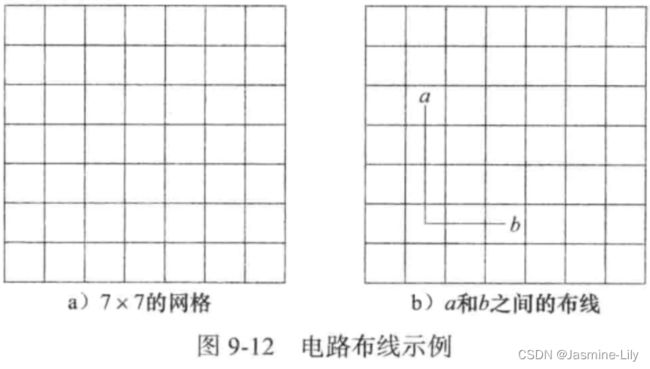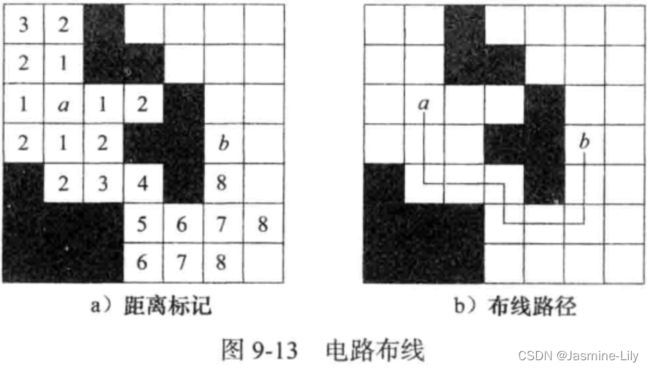《数据结构、算法与应用C++语言描述》-队列的应用-电路布线问题
《数据结构、算法与应用C++语言描述》-队列的应用-电路布线问题
问题描述
在 迷宫老鼠问题中,可以寻找从迷宫入口到迷宫出口的一条最短路径。这种在网格中寻找最短路径的算法有许多应用。例如,在电路布线问题的求解中,一个常用的方法就是在布线区域设置网格,该网格把布线区域划分成nxm个方格,就像迷宫一样(如图 9-12a 所示)。一条线路从一个方格 a 的中心点连接到另一个方格 b 的中心点,转弯处可以采用直角,如图 9-12b 所示。已经有线路经过的方格被“封锁”,成为下一条线路的障碍。我们希望用a 和 b之间的最短路径来布线,以减少信号的延迟。

求解策略
a和b之间的最短路径需要在两个过程中确定。一个是距离标记过程,另一个是路径标记过程。在距离标记过程中,先从位置a开始,把从a可到达的相邻方格都标记为1(表示与a相距为1),然后把从编号为1的方格可到达的相邻方格都标记为2(表示与a相距为2)。这个标记过程继续下去,直至到达b或者没有可到达的相邻方格为止。图9-13a 显示了这种搜索过程的结果,其中 a=(3,2),b=(4,6)。图中的阴影部分是被封锁的方格。
一旦到达 b,b 的编号便是 b 与 a之间的距离(在图 9-13a 中,b上的标号为 9)。距离标记过程结束之后,路径标记过程开始。从方格 b 开始,首先移动到一个其编号比b的编号小1的相邻方格上。在图9-13a中,我们从b移到方格(5,6)。接下来,从方格(5,6)移到比当前编号小 1 的相邻位置上。重复这个过程,直至到达 a 为止。在图 9-13a 的例子中,从(5,6),然后移到(6,6)、(6,5)、(6,4)、(5,4),等等。图 9-13b 给出了所得到的路径,它是(3,2)和(4,6)之间的最短路径。注意,最短路径不是唯一的,(3,2)、(3,3)、(4,3)、(5,3)、(5,4)、(6,4)、(6,5)、(6,6)、(5,6)、(4,6)是另一条最短路径。

代码
#include 运行结果
C:\Users\15495\Documents\Jasmine\Work\coding\cmake-build-debug\coding.exe
鐢佃矾甯冪嚎闂********************
Please enter the size of Grid-Matrix:7
Please enter Grid[1,1]:0
Please enter Grid[1,2]:0
Please enter Grid[1,3]:1
Please enter Grid[1,4]:0
Please enter Grid[1,5]:0
Please enter Grid[1,6]:0
Please enter Grid[1,7]:0
Please enter Grid[2,1]:0
Please enter Grid[2,2]:0
Please enter Grid[2,3]:1
Please enter Grid[2,4]:1
Please enter Grid[2,5]:0
Please enter Grid[2,6]:0
Please enter Grid[2,7]:0
Please enter Grid[3,1]:0
Please enter Grid[3,2]:0
Please enter Grid[3,3]:0
Please enter Grid[3,4]:0
Please enter Grid[3,5]:1
Please enter Grid[3,6]:0
Please enter Grid[3,7]:0
Please enter Grid[4,1]:0
Please enter Grid[4,2]:0
Please enter Grid[4,3]:0
Please enter Grid[4,4]:1
Please enter Grid[4,5]:1
Please enter Grid[4,6]:0
Please enter Grid[4,7]:0
Please enter Grid[5,1]:1
Please enter Grid[5,2]:0
Please enter Grid[5,3]:0
Please enter Grid[5,4]:0
Please enter Grid[5,5]:1
Please enter Grid[5,6]:0
Please enter Grid[5,7]:0
Please enter Grid[6,1]:1
Please enter Grid[6,2]:1
Please enter Grid[6,3]:1
Please enter Grid[6,4]:0
Please enter Grid[6,5]:0
Please enter Grid[6,6]:0
Please enter Grid[6,7]:0
Please enter Grid[7,1]:1
Please enter Grid[7,2]:1
Please enter Grid[7,3]:1
Please enter Grid[7,4]:0
Please enter Grid[7,5]:0
Please enter Grid[7,6]:0
Please enter Grid[7,7]:0
The Grid =
1 1 1 1 1 1 1 1 1
1 0 0 1 0 0 0 0 1
1 0 0 1 1 0 0 0 1
1 0 0 0 0 1 0 0 1
1 0 0 0 1 1 0 0 1
1 1 0 0 0 1 0 0 1
1 1 1 1 0 0 0 0 1
1 1 1 1 0 0 0 0 1
1 1 1 1 1 1 1 1 1
Please enter the start node:3 2
Please enter the end node:4 6
The path = (4,6), (5,6), (6,6), (6,5), (6,4), (5,4), (5,3), (5,2), (4,2), (3,2),
Process finished with exit code 0